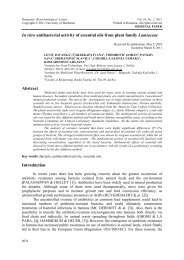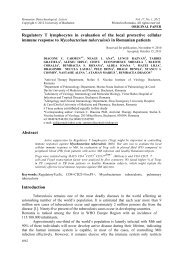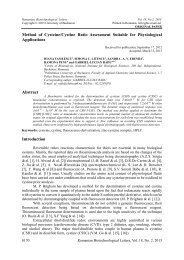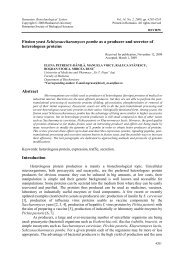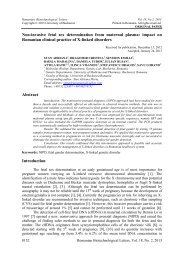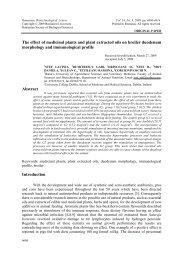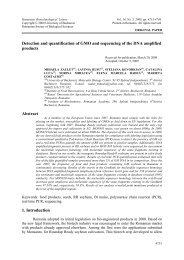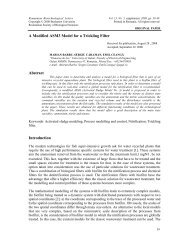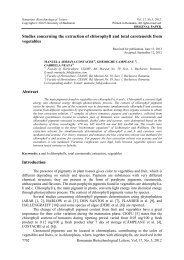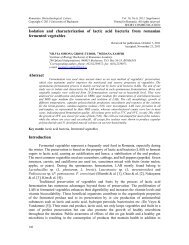The use of RAPD and ISSR markers for genetic ... - Rombio.eu
The use of RAPD and ISSR markers for genetic ... - Rombio.eu
The use of RAPD and ISSR markers for genetic ... - Rombio.eu
You also want an ePaper? Increase the reach of your titles
YUMPU automatically turns print PDFs into web optimized ePapers that Google loves.
VELICEVICI GIANCARLA, MADOŞĂ EMILIAN, ŞUMĂLAN RADU,<br />
CIULCA SORIN,POPESCU SORINA, PETOLESCU CERASELA<br />
Table 4. <strong>The</strong> coefficient values <strong>of</strong> correlation among <strong>RAPD</strong> primers under the <strong>genetic</strong> similarity aspect <strong>of</strong> the<br />
barley cultivars studied<br />
Primers P-1 P-16 P-17 P-27 OPA5 OPA11 OPG2 E-6 A-16<br />
P-1 - 0,072 0,178*** 0,334*** 0,246*** 0,205*** 0,170** 0,027 0,182***<br />
P-16 - 0,323*** 0,168** 0,129* 0,317*** 0,101 0,149** 0,090<br />
P-17 - 0,383*** 0,270*** 0,170** 0,355*** 0,392*** 0,192***<br />
P-27 - 0,536*** 0,267*** 0,338*** 0,177*** 0,210***<br />
OPA5 - 0,107* 0,251*** 0,137* 0,269***<br />
OPA11 - 0,152** 0,137* 0,079<br />
OPG2 - 0,387*** 0,183***<br />
E-6 - 0,171**<br />
A-16 -<br />
r 5% = 0,105; r 1% = 0,138; r 0,1% = 0,176;<br />
<strong>The</strong> six alleles common identified <strong>for</strong> to all the 19 th genotypes studied (Table 5) could<br />
be considered specific <strong>markers</strong> <strong>RAPD</strong> <strong>for</strong> the barley.<br />
Table 5. Specific <strong>RAPD</strong> alleles common <strong>for</strong> all the barley cultivars studied<br />
No.<br />
Specific alleles<br />
1 OPG2-400pb<br />
2. P1-400pb<br />
3. P27-600pb<br />
4. P16-530pb<br />
5. P16-650pb<br />
6. P16-850pb<br />
Inter simple sequence repeat (<strong>ISSR</strong>)-PCR is a technique, which involves the <strong>use</strong> <strong>of</strong><br />
microsatellite sequences as primers in a polymerase chain reaction to generate multilocus<br />
<strong>markers</strong>. It is a simple <strong>and</strong> quick method that combines most <strong>of</strong> the advantages <strong>of</strong><br />
microsatellites (SSRs) <strong>and</strong> amplified fragment length polymorphism (AFLP) to the<br />
universality <strong>of</strong> r<strong>and</strong>om amplified polymorphic DNA (<strong>RAPD</strong>). <strong>ISSR</strong> <strong>markers</strong> are highly<br />
polymorphic <strong>and</strong> are <strong>use</strong>ful in studies on <strong>genetic</strong> diversity, phylogeny, gene tagging, genome<br />
mapping <strong>and</strong> evolutionary biology [25] .<strong>ISSR</strong> <strong>markers</strong> have been <strong>use</strong>d <strong>for</strong> studies <strong>of</strong><br />
hybridization <strong>and</strong> hybrid speciation [2], population <strong>and</strong> conservation <strong>genetic</strong>s [7], <strong>and</strong><br />
systematic investigations in natural populations [20].<br />
Among the tested <strong>ISSR</strong> primers, only five amplified polymorphic <strong>ISSR</strong> loci,<br />
resulting a rate <strong>of</strong> polymorphism with values between 57,14% in case <strong>of</strong> primer 810 <strong>and</strong><br />
100% <strong>for</strong> the first 811, HB12, HB15 (Table.6). <strong>The</strong> amplified fragments had size among 150<br />
<strong>and</strong> 600 pb <strong>for</strong> HB-15 primer, while 810 primer registered the highest amplitude <strong>of</strong> amplified<br />
fragments size (950- 5100 pb). <strong>The</strong> average number <strong>of</strong> polymorphic b<strong>and</strong>s per primer was 9.2<br />
with an average rate <strong>of</strong> polymorphism being 89,13 %.<br />
<strong>The</strong> total <strong>of</strong> polymorphism generated by a certain primer (PIC) presented values<br />
among 0,245 to 811 <strong>and</strong> 0,391 to 810. <strong>The</strong> discrimination index (PI) registered values among<br />
1,562 <strong>for</strong> primer 810 <strong>and</strong> 2,803 <strong>for</strong> HB15 primer.<br />
Table 6. Polymorphism rate <strong>of</strong> barley cultivars through <strong>ISSR</strong> primers<br />
No.. Primers Nucleotide No. b<strong>and</strong>s Polymorphis Range <strong>of</strong> PIC PI<br />
sequence Total No <strong>of</strong> Polymorphic m (%) size b<strong>and</strong>s x ± s<br />
x<br />
(5’-3’) fragments fragments<br />
(pb)<br />
1 HB-12 (CAC)3GC 9 9 100 175-850 0,309+0,044 2,781<br />
2 HB-14 (CTC)3GC 12 10 83.33 200-1400 0,264+0,053 1,806<br />
3 HB-15 (GTG)3GC 9 9 100 150-600 0,311+0,059 2,803<br />
4 810 (GA) 8 T 7 4 57.14 950-5100 0,391+0,111 1,562<br />
5 811 (GA) 8 C 9 9 100 950-2000 0,245+0,053 2,205<br />
7498 Romanian Biotechnological Letters, Vol. 17, No. 4, 2012



